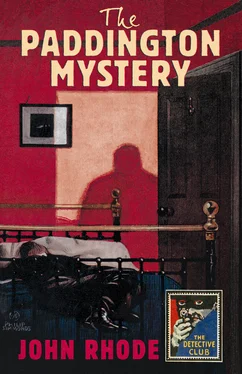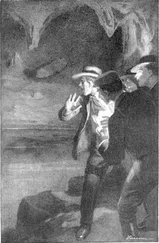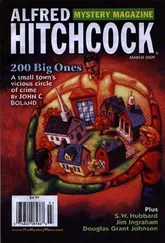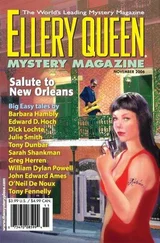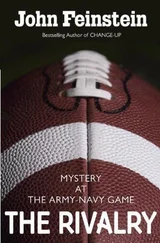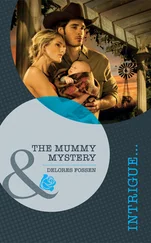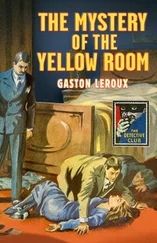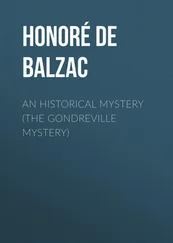A STORY OF CRIME
BY
PLUS
‘THE PURPLE LINE’
WITH AN INTRODUCTION BY
TONY MEDAWAR
Copyright Table of Contents Cover Title Page Copyright The Paddington Mystery Introduction Chapter I Chapter II Chapter III Chapter IV Chapter V Chapter VI Chapter VII Chapter VIII Chapter IX Chapter X Chapter XI Chapter XII Chapter XIII Chapter XIV Chapter XV The Purple Line Keep Reading … The Detective Story Club About the Publisher
COLLINS CRIME CLUB
an imprint of HarperCollins Publishers Ltd
1 London Bridge Street
London SE1 9GF
www.harpercollins.co.uk
First published in Great Britain by Geoffrey Bles 1925
‘The Purple Line’ first published in the Evening Standard 1950
Copyright © Estate of John Rhode 1925, 1950
Introduction © Tony Medawar 2018
Cover layout design © HarperCollins Publishers Ltd 2018
A catalogue copy of this book is available from the British Library.
This novel is entirely a work of fiction. The names, characters and incidents portrayed in it are the work of the author’s imagination. Any resemblance to actual persons, living or dead, events or localities is entirely coincidental.
All rights reserved under International and Pan-American Copyright Conventions. By payment of the required fees, you have been granted the non-exclusive, non-transferable right to access and read the text of this e-book on screen. No part of this text may be reproduced, transmitted, down-loaded, decompiled, reverse engineered, or stored in or introduced into any information storage and retrieval system, in any form or by any means, whether electronic or mechanical, now known or hereinafter invented, without the express written permission of HarperCollins.
Source ISBN: 9780008268848
Ebook Edition © June 2018 ISBN: 9780008268855
Version: 2018-02-06
Table of Contents
Cover
Title Page THE PADDINGTON MYSTERY A STORY OF CRIME BY
Copyright
The Paddington Mystery
Introduction
Chapter I
Chapter II
Chapter III
Chapter IV
Chapter V
Chapter VI
Chapter VII
Chapter VIII
Chapter IX
Chapter X
Chapter XI
Chapter XII
Chapter XIII
Chapter XIV
Chapter XV
The Purple Line
Keep Reading …
The Detective Story Club
About the Publisher
‘THE DETECTIVE STORY CLUB is a clearing house for the best detective and mystery stories chosen for you by a select committee of experts. Only the most ingenious crime stories will be published under the THE DETECTIVE STORY CLUB imprint. A special distinguishing stamp appears on the wrapper and title page of every THE DETECTIVE STORY CLUB book—the Man with the Gun. Always look for the Man with the Gun when buying a Crime book.’
Wm. Collins Sons & Co. Ltd., 1929
Now the Man with the Gun is back in this series of COLLINS CRIME CLUB reprints, and with him the chance to experience the classic books that influenced the Golden Age of crime fiction.
THE writer best known as ‘John Rhode’ was born Cecil John Charles Street on 3 May 1884 in the British territory of Gibraltar. His mother was descended from a wealthy Yorkshire family and his father was a distinguished Commander in the British Army who—at the time of his son’s birth—was serving in Gibraltar as Colonel-in-Chief of the Second Battalion of Scottish Rifles.
Shortly after his birth John Street’s parents returned to England where, not long after John’s fifth birthday, his father died unexpectedly. John and his widowed mother went to live with her father, and in 1895 John was sent to Wellington College in Berkshire. John did well in his academic studies and, perhaps unsurprisingly given the approach he took to detective stories, he excelled in the sciences. At the age of 16, John left school to attend the Royal Military Academy at Woolwich and, on the outbreak of the Great War, as it was then called, he enlisted, rising to the rank of Major by March 1918. While he was wounded three times, John Street’s main contribution to the war effort concerned the promulgation of allied propaganda, for which he was awarded the Order of the British Empire in the New Year Honours List for 1918 and also the prestigious Military Cross. As the war came to an end John Street moved to a new propaganda role in Dublin Castle in Ireland, where he would be responsible for countering the campaigning of the Irish nationalists during the so-called war of Irish independence. But the winds of change were blowing across Ireland and the resolution—or rather the partial resolution—of the ‘Irish Question’ would soon come in the form of a treaty and the partition of the island of Ireland. As history was made, Street was its chronicler, at least from the British perspective.
During the 1920s, other than making headlines for falling down a lift shaft, John Street spent most of his time at a typewriter, producing a fictionalised memoir of the war and political studies of France, Germany, Hungary and Czechoslovakia, as well as two biographies. He also wrote a few short stories and articles on an eclectic range of subjects including piracy, camouflage and concealment, Slovakian railways, the value of physical exercise, peasant art, telephony, and the challenges of post-war reconstruction. He even found time to enter crossword competitions and, reflecting his keen interest in what is now known as ‘true crime’, he published the first full-length study of the trial of Constance Kent, who was convicted for one of the most gruesome murders of the nineteenth century at Road House in Kent. John also found time to write three thrillers and a wartime romance. However, while his early books found some success, the Golden Age of detective stories had arrived, and he decided to try his hand at the genre.
The first challenge was to create a great detective, someone to rival the likes of Roger Sheringham and Hercule Poirot, with whose creators John Street would soon be on first name terms. Street’s great detective was the almost supernaturally intelligent Lancelot Priestley, a former academic, who in the words of the critic Howard Haycraft was ‘fairly well along in years, without a sense of humour and inclined to dryness’. Dr Priestley’s first case, published in October 1925, would be The Paddington Mystery . Doctor—or rather Professor—Priestley was an immediate success, and Street was quick to respond, producing another six novels in short order. As well as Priestley, Street’s ‘John Rhode’ novels often feature one or both of two Scotland Yard detectives, Inspector Hanslet and Inspector Jimmy Waghorn who would in later years appear without Priestley in several radio plays and a short stage play.
By 1930, John Street was no longer just a highly decorated former Army Major with a distinguished career in military intelligence—he had now written a total of 25 books under various pseudonyms. He was 45 years old, and he was just getting started. As ‘John Rhode’ he would produce a total of 76 novels, all but five of which feature Dr Priestley and one of which was based on the notorious Wallace case. But, while writing as ‘John Rhode’, Street also became ‘Miles Burton’, under which pseudonym he wrote 63 novels featuring Desmond Merrion, a retired naval officer who may well have been named after Merrion Street in Dublin. There also exists an unfinished and untitled final novel, inspired it would appear by the famous Green Bicycle Case. The ‘Rhode’ and ‘Burton’ detective mysteries are similar, but whereas Priestley is generally dry and unemotional, Merrion is more of a gentleman sleuth in the manner of Philip Trent or Lord Peter Wimsey. Both Merrion and Priestley are engaged from time to time by Scotland Yard acquaintances, all of whom are portrayed respectfully rather than as the servile and unimaginative policemen created by some of Street’s contemporaries.
Читать дальше
